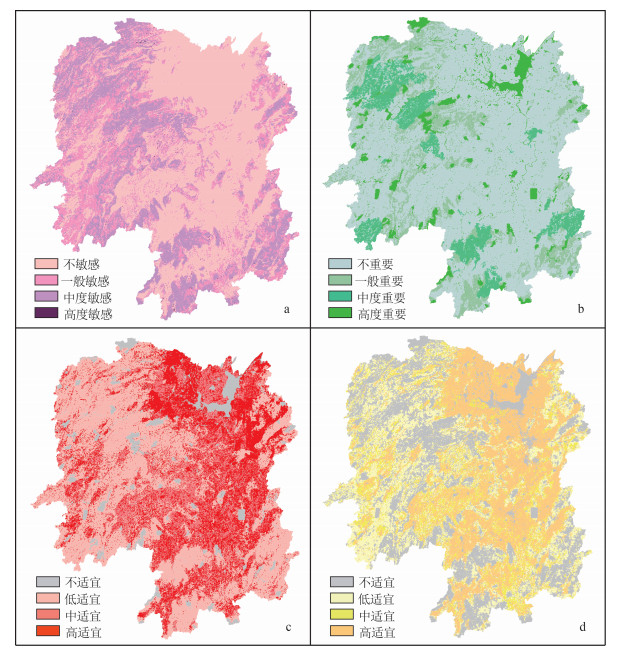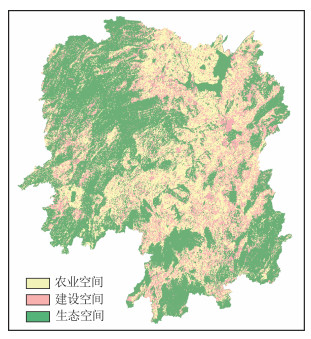The method of three kinds of space division based on natural suitability of land space: A case study of Hu'nan Province
-
摘要:
为满足国土空间规划的需求,从自然条件、管理制度构建了建设用地、耕地适宜性评价的禁止性指标和限制性指标。评价中,首先定性分析区域内具体指标对农业、建设等不同功能的限制性,对生态极重要或极敏感区、水域等禁止性指标"一票否决",然后设定不同的指标等级分值、权重,进行综合打分,限制性指标以分值(0~100,分数越高,表示限制性越低,适宜性越高)和权重对国土空间开发适宜性进行限制。结合生态重要性和敏感性评价,以GIS技术为基础,比较同一地块生态、农业、建设适宜性等级,按三者中等级最高的确定空间类型,如果适宜性等级相同,则根据地块的具体资源环境属性、土地利用现状确定空间类型,结合生态系统完整性、农业现代化需求等调整优化生态、农业、建设三类空间。以湖南省为例进行了实证研究,划分建设开发空间20.22%,农业开发空间30.3%,生态保护空间49.48%。
Abstract:In order to satisfy the requirement of space planning, the authors have constructed the prohibitive and restrictive factors of suitability evaluation of construction land and cultivated land with natural geographical condition and institutional policy. In the evaluation, firstly, the restriction of specific indicators on dierent functions such as agriculture and construction in the region is qualitatively analyzed, and the prohibitive indicators such as ecologically important or extremely sensitive areas and waters are "vetoed by one vote". Then, different index grades and weights ae set for comprehensive scoring. The prohibitive factors mens "no" for construction land and cultivated land, and the restrictive factors are limited by value(0~100, the higher the better) and the weight on the suitability. Combined with the evaluation of ecological importance and sensitivity, based on GIS technology, and comparing the suitability grades of ecology, agriculture and construction in the same plot, the authors determine the space types according to the highest level of the three. If the suitability grades ae the same, the space types are determined according to the specific resource and environment attributes of the plot and the current situation of land use, and the ecological, agricultural and construction spaces are adjusted and optimized according to the integrity of the ecosystem and the needs of agricultural modernization. Taking Hu'nan Province as an example, the authors divided the whole space into the construction with development space (20.22%), the agricultural development space(30.3%), the ecological protection space(49.48%).
-
Keywords:
- land space /
- natural suitability /
- three kinds of space /
- method /
- Hu'nan Province
-
致谢: 论文撰写过程中得到中国地质环境监测院殷志强博士的指导和帮助,李瑞敏教授级高工及另一位审稿专家提出了建设性意见,在此一并致谢。
-
表 1 建设开发适宜性评价指标体系
Table 1 Factors of suitability evaluation of construction land
指标 指标分类 分值 权重 禁止性
指标生态红线 生态红线范围内 0 生态红线范围外 1 生态保护区 生态保护区范围内 0 生态保护区范围外 1 基本农田 基本农田范围内 0 基本农田范围外 1 风景名胜
保护区风景名胜保护区内 0 风景名胜保护区外 1 土壤环境 经评估不适合建设用地开发的 0 经评估适合建设用地开发的 1 水环境 经评估不适合建设用地开发的 0 经评估适合建设用地开发的 1 坡度 25°以上 0 蓄滞洪区 重要蓄滞洪区 0 地质灾害 严重采空塌陷区 0 限制性
指标坡度 15°~25° 30 0.4 6°~15° 70 0°~6° 100 蓄滞洪区 一般蓄滞洪区 30 0.3 蓄滞洪保留区 60 非蓄滞洪区 100 地质灾害 崩塌、滑坡、泥石流等突发
地质灾害高易发区40 0.3 崩塌、滑坡、泥石流等突发
地质灾害中易发区60 崩塌、滑坡、泥石流等突发
地质灾害低易发区80 无地质灾害风险 100 表 2 农业开发适宜性评价指标体系
Table 2 Factors of suitability evaluation of cultivated land
指标 指标分类 分值 权重 禁止性
指标生态红线 生态红线范围内 0 生态红线范围外 1 生态保护区 生态保护区范围内 0 生态保护区范围外 1 风景名胜保护区 风景名胜保护区内 0 风景名胜保护区外 1 土壤环境 劣于Ⅲ类土壤 0 Ⅲ类或优于Ⅲ类土壤 1 地表水环境 劣于Ⅴ类地表水 0 Ⅴ类或优于Ⅴ类地表水 1 地下水环境 劣于Ⅴ类地下水 0 Ⅴ类或优于Ⅴ类地下水 1 洪水位线 河流、湖泊洪水位线以下 0 其他 1 土层厚度 小于30 cm 0 大于30 cm 1 坡度 25°以上 0 限制性
指标坡度 15°~25° 20 0.1 6°~15° 60 2°~6° 80 0°~2° 100 蓄滞洪区 重要蓄滞洪区 30 0.1 一般蓄滞洪区 50 蓄滞洪保留区 70 非蓄滞洪区 100 土地利用现状 林地、水域 10 0.3 草地、园地 20 自然保留地 30 其他用地 50 建设用地 70 其他农用地 90 耕地 100 地质灾害 崩塌、滑坡、泥石流等
突发地质灾害高易发区60 0.05 崩塌、滑坡、泥石流等
突发地质灾害中易发区80 崩塌、滑坡、泥石流等
突发地质灾害低易发区90 无地质灾害风险 100 土层厚度 30~60cm 60 0.15 60~90cm 80 >90cm 100 土壤质地 砾质土 30 0.2 砂土 50 粘土 80 壤土 100 地貌 峡谷、陡坡山地 10 0.1 缓坡山地 30 丘陵 60 岗地、台地 90 平原 100 表 3 国土空间开发适宜性评价结果
Table 3 Evaluation results of land space development suitability
生态重要性 极重要 高度重要 中等重要 一般重要 网格数 15635 20153 35376 143531 百分比/% 7.28 9.39 16.48 66.85 生态敏感性 极敏感 高度敏感 中度敏感 一般敏感 网格数 199 50889 50962 112645 百分比/% 0.09 23.70 23.74 52.47 农业开发
适宜性高适宜 中适宜 低适宜 不适宜 网格数 74352 25254 50400 64689 百分比/% 34.63 11.76 23.48 30.13 建设开发
适宜性高适宜 中适宜 低适宜 不适宜 网格数 58352 41878 98652 15813 百分比/% 27.18 19.51 45.95 7.37 -
喻忠磊, 张文新, 梁进社, 等.国土空间开发建设适宜性评价研究进展[J].地理科学进展, 2015, 34(9) :1107-1122. http://d.old.wanfangdata.com.cn/Periodical/dlkxjz201509004 刘纪远, 匡文慧, 张增祥, 等.20世纪80年代末以来中国土地利用变化的基本特征与空间格局[J].地理学报, 2014, 69(1) :3-14. http://d.old.wanfangdata.com.cn/Periodical/dlxb201401001 魏采用, 徐友宁, 严瑾, 等.基于遥感技术的宁东煤炭基地土地利用变化及驱动力分析[J].地质通报, 2018, 37(12) :2169-2175. http://dzhtb.cgs.cn/gbc/ch/reader/view_abstract.aspx?file_no=20181206&flag=1 唐常春, 孙威.长江流域国土空间开发适宜性综合评价[J].地理学报, 2012, 67(12) :1587-1598. doi: 10.11821/xb201212001 何英彬, 陈佑启, 杨鹏, 等.国外基于GIS土地适宜性评价研究进展及展望[J].地理科学进展, 2009, 28(6) :898-904. http://d.old.wanfangdata.com.cn/Periodical/dlkxjz200906010 钟珊, 赵小敏, 郭熙, 等.基于空间适宜性评价和人口承载力的贵溪市中心城区城市开发边界的划定[J].自然资源学报, 2018, 33(5) :83-94. http://d.old.wanfangdata.com.cn/Periodical/zrzyxb201805007 吴艳娟, 杨艳昭, 杨玲, 等.基于"三生空间"的城市国土空间开发建设适宜性评价——以宁波市为例[J].资源科学, 2016, 38(11) :2072-2081. http://www.wanfangdata.com.cn/details/detail.do?_type=perio&id=zykx201611006 孙伟, 陈雯.市域空间开发适宜性分区与布局引导研究——以宁波市为例[J].自然资源学报, 2009, 24(3) :402-413. doi: 10.3321/j.issn:1000-3037.2009.03.004 刘焱序, 彭建, 韩忆楠, 等.基于OWA的低丘缓坡建设开发适宜性评价——以云南大理白族自治州为例[J].生态学报, 2014, 34(12) :3188-3197. http://www.wanfangdata.com.cn/details/detail.do?_type=perio&id=stxb201412007 丁建中, 陈逸, 陈雯.基于生态-经济分析的泰州空间开发适宜性分区研究[J].地理科学, 2008, 28(6) :842-848. doi: 10.3969/j.issn.1000-0690.2008.06.023 党丽娟, 徐勇, 汤青, 等.广西西江沿岸后备适宜建设用地潜力及空间分布[J].自然资源学报, 2014, (3) :387-397. http://www.wanfangdata.com.cn/details/detail.do?_type=perio&id=zrzyxb201403003 赵晓丹, 杨雅萍, 荆文龙.基于AHP的湖南省耕地适宜性综合评价[J].水土保持研究, 2015, 22(2) :219-223. http://d.old.wanfangdata.com.cn/Periodical/stbcyj201502041 焦利民, 刘耀林.土地适宜性评价的模糊神经网络模型[J].武汉大学学报(信息科学版), 2004, 29(6) :513-516. http://d.old.wanfangdata.com.cn/Periodical/whchkjdxxb200406011 纪涛, 杜雯翠, 江河.推进城镇、农业、生态空间的科学分区和管治的思考[J].环境保护, 2017, 45(21) :70-71. http://www.wanfangdata.com.cn/details/detail.do?_type=perio&id=hjbh201721018 张凤荣, 赵华甫, 黄大全, 等.基于宜居城市建设的北京市农业产业空间布局[J].资源科学, 2008, 30(2) :162-168. http://d.old.wanfangdata.com.cn/Periodical/zykx200802001 杨子生.山区城镇建设用地适宜性评价中的坡度因子分析——以云南省德宏州为例[J].自然资源学报, 2016, 31(1) :64-76. http://www.cnki.com.cn/Article/CJFDTotal-ZRZX201601006.htm 李和平, 刘劲松, 马宇钢.山地村庄建设用地适宜性评价研究[J].规划师, 2015, 31(8) :93-99. doi: 10.3969/j.issn.1006-0022.2015.08.016 侯传河, 沈福新.我国蓄滞洪区规划与建设的思路[J].中国水利, 2010, (20) :40-44. doi: 10.3969/j.issn.1000-1123.2010.20.013 金德山.建设用地地质灾害危险性评估中几个问题的思考[J].中国地质灾害与防治学报, 2004, 15(4) :101-103. doi: 10.3969/j.issn.1003-8035.2004.04.022 关小克, 张凤荣, 郭力娜, 等.北京市耕地多目标适宜性评价及空间布局研究[J].资源科学, 2010, 32(3) :580-587. http://d.old.wanfangdata.com.cn/Periodical/zykx201003028 彭瑶, 姚小军, 陈然, 等.耕地适宜性评价在村级土地利用规划中的应用——以义乌市岩南村为例[J].水土保持通报, 2013, 33(2) :116-119. http://www.wanfangdata.com.cn/details/detail.do?_type=perio&id=stbctb201302025 环境保护部.生态保护红线划定技术指南.2017. 国家环境保护局, 国家技术监督局.土壤环境质量标准(GB 15618—1995).1995. 国家环境保护总局, 国家质量监督检验检疫总局.地表水环境质量标准(GB 3838—2002).2002. 国家质量监督检验检疫总局, 国家标准化管理委员会.地下水质量标准(GB/T 14848-2017).2017. 国土资源部办公厅.全国耕地后备资源调查评价技术方案.2014. -
期刊类型引用(14)
1. 许珠,樊卢丽,蒋翔,陈焰明. 多规合一背景下村域“三生空间”划定与布局探讨. 现代农业研究. 2024(08): 78-85 .  百度学术
百度学术
2. 赵欣宇,布仁吉日嘎拉,敖登高娃. 基于适宜性评价的草原牧区县(旗)域国土三类空间划定研究. 环境生态学. 2023(06): 47-53 .  百度学术
百度学术
3. 黄栋良,蒋正文,浣雨柯,李曼懿,宋磊,张宝一. 湖南省生态风险源-暴露-效应模型评价. 地理信息世界. 2022(02): 67-73 .  百度学术
百度学术
4. 赵强,李家会,李小云. 基于MSS模型的“三生空间”识别与优化——以衡阳市为例. 国土资源导刊. 2022(03): 70-75 .  百度学术
百度学术
5. 魏国杰,穆战强,朱飞. 基于改进随机森林算法的国土空间规划用地分类研究. 科技通报. 2022(10): 11-15+28 .  百度学术
百度学术
6. 张燕纯. 基于供需平衡控制的市中心土地要素市场动态监测. 测绘标准化. 2022(04): 63-68 .  百度学术
百度学术
7. 陈艺,蔡海生,张学玲,曾珩,邵晖,洪土林. 基于MCE的饶河流域国土空间生态质量综合评价及其空间分异. 生态学报. 2021(06): 2236-2247 .  百度学术
百度学术
8. 付涛,易宏,吴俐民,李玉龙. 适宜性评价与模型模拟的三类空间划定研究. 测绘科学. 2021(06): 164-173 .  百度学术
百度学术
9. 林燕,白秀佳,叶泽宇,张衡. 基于ArcGIS的南通市农业生产适宜性评价. 地质通报. 2021(06): 968-977 .  本站查看
本站查看
10. 李云辉. 国土空间功能分区管控研究. 住宅与房地产. 2021(28): 8-9 .  百度学术
百度学术
11. 项广鑫,符金豪,曾丽婷,蒋星祥,曾毅. 基于“双评价”的城镇开发边界划定技术——以湘潭县中心城区为例. 自然资源学报. 2020(10): 2401-2414 .  百度学术
百度学术
12. 卫晓锋,王京彬,孙厚云,殷志强,何泽新,贾凤超,李霞,刘宏伟,张竞. 基于地质建造探索承德市土地利用优化路径. 水文地质工程地质. 2020(06): 15-25 .  百度学术
百度学术
13. 王佳运,毕俊擘,杨旭东,李彦娥,马红娜,罗金. 山西吕梁山区城镇边坡风险分级与优化. 地质通报. 2020(12): 2004-2012 .  本站查看
本站查看
14. 赖国华,胡宝清,李敏,林树高. 桂西南-北部湾地区“三生”空间适宜性评价. 水土保持通报. 2020(06): 221-227+331 .  百度学术
百度学术
其他类型引用(15)




 下载:
下载:

